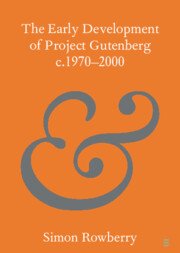6 results
Chapter 1 - Bookness
-
- Book:
- E-books and ‘Real Books’
- Published online:
- 07 December 2024
- Print publication:
- 23 January 2025, pp 14-34
-
- Chapter
-
- You have access
- Open access
- HTML
- Export citation

E-books and ‘Real Books’
- Digital Reading and the Experience of Bookness
-
- Published online:
- 07 December 2024
- Print publication:
- 23 January 2025
-
- Book
-
- You have access
- Open access
- Export citation
Chapter 8 - The Literary Marketplace
-
-
- Book:
- The Cambridge Companion to Literature in a Digital Age
- Published online:
- 29 November 2024
- Print publication:
- 14 November 2024, pp 137-153
-
- Chapter
- Export citation
Chapter 21 - Digital Editions
- from Part III - Applications
-
-
- Book:
- Technology and Literature
- Published online:
- 30 November 2023
- Print publication:
- 14 December 2023, pp 396-416
-
- Chapter
- Export citation

The Early Development of Project Gutenberg c.1970–2000
-
- Published online:
- 15 June 2023
- Print publication:
- 29 June 2023
-
- Element
- Export citation
“You can build it but will they come?” A Trial Implementation of eTextbooks at The College of Law
-
- Journal:
- Legal Information Management / Volume 11 / Issue 4 / December 2011
- Published online by Cambridge University Press:
- 08 December 2011, pp. 238-240
- Print publication:
- December 2011
-
- Article
- Export citation

